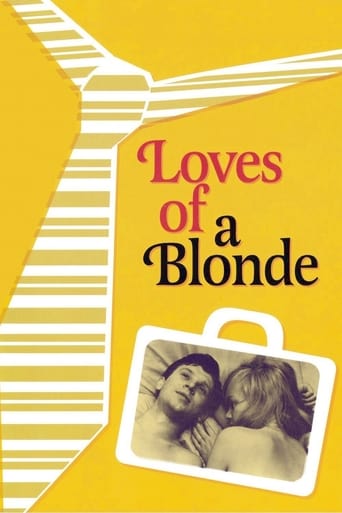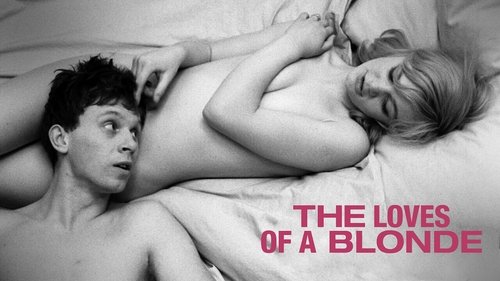


Czech-American screenwriter, professor and director Milos Forman's second feature film which was shot in 1964, entirely on location in Zruc nad Sázavou and written by Ivan Passar, Jaroslav Papousek and Milos Forman, tells the story about a young working-class woman named Andula who lives in a small town called Zruc in Czechoslovakia where the local men is outnumbered by the local female population. Andula is engaged with her boyfriend Tondo, but when she attends a social gathering with her friends Marie and Jana she meets a pianist named Milda and gets involved in a new romance.This slow-paced romantic comedy from the mid-1960s is a brilliantly written and directed social satire which portrays a young woman's non-conformist love life in a very low-keyed manner while making a sharp critique of notions of democracy during a period when the Czech government was still being ruled by a Communist regime. Slightly sad and charmingly humorous, this dialog-driven and condensed study of character from the Czechoslovak New Wave has a gifted cast primarily consisting of non-professional actors.The efficient bittersweet atmosphere which sets the tone and which is reinforced by the fine black-and-white cinematography by Milos Forman's frequent collaborator, Czech cinematographer Miroslav Ondríscek and the jazzy score by Czech composer Evzen Illín. Milos Forman's vividly narrated film gained an Academy Award nomination and a Golden Globe nomination for Best Foreign Language film in 1967, was nominated for the Golden Lion at the Venice Film Festival in 1965 and is emphasized by Czech actress Hana Brejchová's memorable and understated acting performance in her debut role as the charming Andula who is looking for love.
... View MoreHere's a romantic comedy with some drama undertones made with charm and lots of style by a Milos Forman way before "Amadeus" and "One Flew Over a Cuckoo's Nest"; this is a film made during his Czech phase which is also interesting. He's always a great director, his films are very sharp and he knows exactly how to balance drama and comedy in a perfect composition, looks like a great chemist and this film is quite a surprise if you consider his other works. But it is equally great! In "Lásky Jedné Plavovlásky" ("Loves of a Blonde") Hana Brejchová plays Andula, a pretty young girl living in a small city whose majority is formed by young girls like her waiting for a nice boy to appear. We follow Andula and her friends during a party where they are seen as object of adoration by three soldiers out of duty and way out the girls league since they're quite old for them but they insist with them dancing and paying a bottle of wine they don't even want. But in the same party, there's Milda (Vladimír Pucholt) a young pianist interest in Andula, also a persistent guy who liked Andula and keeps most part of the film trying to make a move on her. He'll be more successful than the soldiers but the destiny awaits some surprises for him...and for her too."Loves of a Blonde" is a humored tale about a woman's journey to the discover of the first love, the enchantments and disenchantment's of it, but also about that old talk about woman's virtue, the value of female honor in not hanging out with too many boys at the same time because this wasn't seen in good eyes by the society (you'll see this in the school scene where the teacher says that to the girls and they make a pledge based on a elevated moral behavior). I quote as "old talk" because times are way different than the one presented in the film and people have another values in terms of almost everything, so what was a something that only men could do, now women can do too if they want; if boys can date or kiss several girls, girls can do the same. It's a quite updated view this film had back in the 1960's in showing Andula trying to not flirt with soldiers in one way but end up talking to them, then later to have a romantic evening with Milda and...she already had a boyfriend as we discover way later. Even though some might condemn this kind of behavior, in the film is presented without any vulgarity and without any excess; it's well humored, very simple and it doesn't demand much from the viewers to make them laugh; laughter comes naturally with "Loves of a Blonde". Among the best moments of the film are the soldier who lost his wedding ring in the ballroom during the party (the whole segment of the party is funny with the unsure soldiers trying to make a move on the girls, then the girls keep saying to themselves they don't the guys near them but can't stop looking at them); Milda's insistent moves on Andula that even includes teaching her how to defend herself from guys like him; the "I don't have a girl in Prague" quote Milda keeps saying trying to amuse the girl saying she's the only one in his life; and segment with Andula visiting Milda's irritating parents (although this moment got more irritating than funny, specially because of the mom, one of the most annoying characters ever presented in a film). Highly recommended. 10/10
... View MoreIn Loves of a Blonde Milos Forman continued dealing with the same subjects he did in his first feature film Black Peter (1964); the aimless youth and the Czechslovakian society. After Loves of a Blonde he started working on his next film, The Firemen's Ball (1966). Once the film was released it caused an incredible strife; over ten thousand firemen announced a strike and Milos Forman was about to get sentenced to jail for 10 years. Fortunately Francois Truffaut, the master of Nouvelle Vague, helped Forman out of the trouble and, so Forman went to United States where he has made some of his most remembered films such as One Flew Over the Cuckoo's Nest and Amadeus.Loves of a Blonde is often overlooked even that it is one of the finest representatives of Eastern Europe new wave or Novi-film. Alongside with Yugoslavian Dusan Makavejev and Czechslovakian Jiri Menzel, Milos Forman was an integral auteur for the movement. It had the same cheer that the Nouvelle Vague did but the Novi-films were much more politically bold and took clear statements against the Communist government - due to which many of the films got banned.Loves of a Blonde is a cheerful tragicomedy. Its protagonist is a working-class girl, Andula who works at a shoe factory. One day she becomes acquainted with a young pianist to whom she falls in love with. The film is quite ruthless but also humane and Forman treats his characters with warm love. He accepts his characters as they are, with their flaws and controversies. In the beginning he portraits a group of three middle-aged army men who try to hit on three teenage girls. The soldiers are portrayed as dumb and self-thinking but also as humane, sympathetic characters.It's strongly a social film. It portrays the 60's Czechslovakia as a dull place with nothing to do; so people try to find their amusement from sexuality and other pleasures. The officers are stupid and selfish, as is the society. The teenagers are also naive but try their best to survive. The first sequence where the men try to hit on the girls is brilliant and full of significance; one man takes a wedding ring off his finger, drops it and follows it as it goes through the dancing floor. The men try to send a bottle to the girls but the waiter messes up and takes the bottle to the wrong table. Nothing works.Loves of a Blonde is an ironic social film but also a warm story about love and soul searching. Its characters are lost in a country which has lost its course as well. Whether it's the middle-aged men or the teenage girls, or the young pianist, no one really knows who they are. This is a basic tragicomic element in the films of the new wave. The film is clearly naturalism as it describes Czechslovakia as realistically as possible; mud, old clothes, bad wine and cruddy vehicles. It's paradoxically truly a melancholy love story but also a cheer comedy.
... View MoreThis Czech film from the mid 1960s is a drab piece of socialist realism, in the form of a quite bitter comedy (by Milos Forman, one of the most overrated filmmakers ever). The story: Milda, a young pianist goes to drab industrial small town to play one night, meets the bird-brained working class blonde Andula during the ball, they make love at his hotel room, he returns to Prague, she breaks with her boyfriend after a fight, and decides to go to Prague to meet Milda. As it happens, the pianist lives with his parents, who are totally opposed with Andula staying at their rundown apartment (Not that Milda wants her to stay). It is a quite artless film, and it is also ugly the way Andula is treated throughout. Only redeeming feature is Jana Brejchova's affecting performance as Andula, a not very bright person who seems to have been bruised more than one time by life.
... View More